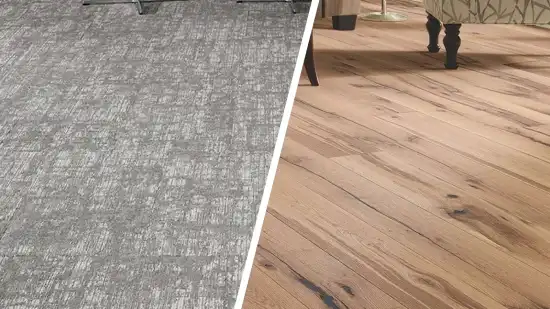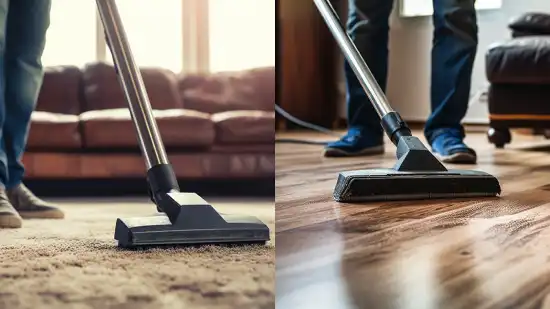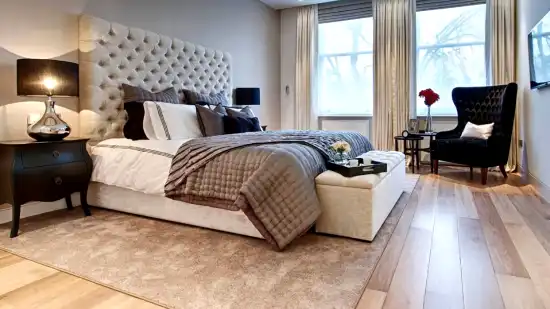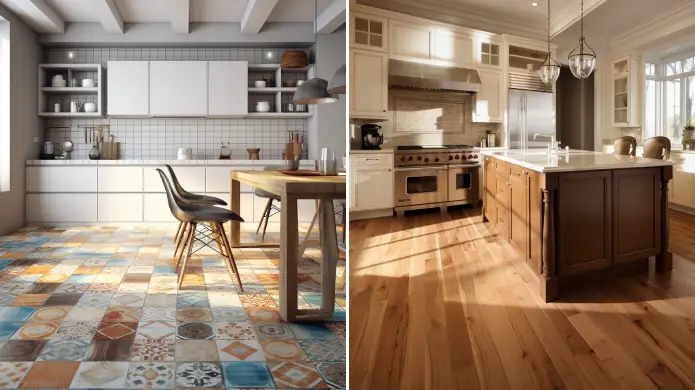You’ll feel relaxed and at ease when you walk into your dream master bedroom, a place of comfort and style. And the choice between carpet and hardwood floors can make all the difference in creating the perfect ambiance here. So, how do they differ in flooring application in your master bedroom?
The carpet is soft and cozy, while hardwood floors provide a timeless and elegant look. And hardwood floors are known for their longevity and resistance to wear and tear, whereas carpets may require more frequent replacement.
Let’s embark on a journey of discovery as we explore the differences between carpet and hardwood floors, revealing the secrets to a truly enchanting space.
Differences Between Carpet vs Hardwood Floor in Master Bedroom

When choosing between carpet and hardwood floors for your master bedroom, there are several key factors to consider. They are as follows:
- Material and appearance
- Durability
- Comfort and insulation
- Allergies and air quality
- Maintenance and cleaning
- Installation and costs
- Aesthetic and resale value
Let’s take a closer look at each of these factors to determine which type of flooring is better for your master bedroom.
No 01: Material and Appearance
Carpets are made from fibers such as nylon, polyester, wool, or a blend. They provide a soft and comfortable surface underfoot, offering warmth and cushioning. Carpets come in various colors, patterns, and textures, allowing for versatile design options.
In contrast, hardwood flooring is made from solid wood planks or engineered wood, with a layer of real wood on top of the plywood. Hardwood offers a timeless, elegant appearance and brings a natural, warm aesthetic to the room. It is available in different wood species with unique grain patterns and hues.
Although carpet provides a soft and comfortable surface, hardwood flooring offers a timeless, elegant appearance.
No 02: Durability
You’ll be pleased to know that hardwood floors are highly durable and can withstand the test of time.
Carpets can wear out over time, especially in high-traffic areas. They are prone to staining, matting, and showing signs of wear. The lifespan of a carpet can vary based on the quality of the carpet and the level of foot traffic.
Meanwhile, hardwood floors are resilient and can handle heavy foot traffic without showing signs of wear. They are also less likely to be damaged by spills or accidents, as they can be easily cleaned and maintained.
Should the surface start to show scratches or signs of aging, hardwood floors can be refinished to restore their original appearance.
No 03: Comfort and Insulation
While hardwood floors are elegant and timeless, they can sometimes feel cold and lack the cozy factor that carpets provide.
Area carpets offer a solution by adding a layer of warmth and softness underfoot. They act as a barrier between your feet and the cold hardwood, making your room feel more inviting and comfortable. Also, carpets provide insulation, helping to retain heat during colder seasons and reducing energy costs.
Conversely, Hardwood floors can feel colder to the touch, particularly in colder seasons, and may benefit from area rugs for added comfort and warmth. And hardwood floors may require an insulation pad to help insulate the floor and reduce energy costs.
No 04: Allergies and Air Quality
If allergies are a concern, you should consider how different flooring options can impact indoor air quality.
While providing a soft and cozy feel underfoot, carpets can trap dust, allergens, and pet dander, leading to poor air quality and potential health issues.
On the other hand, hardwood floors are a better choice for allergy sufferers. They don’t trap allergens as much as carpets, contributing to better indoor air quality and reducing allergy-related concerns. With hardwood floors, you can breathe easier and enjoy a cleaner environment in your master bedroom.
No 05: Maintenance and Cleaning

When considering maintenance and cleaning, it is crucial to know that hardwood floors require regular sweeping or mopping to keep them clean and free from dirt and debris. Unlike carpets, which can trap allergens and require frequent vacuuming, hardwood floors offer a smoother surface that is easier to maintain.
Here are three key points to keep in mind when caring for hardwood floors:
- Use a soft-bristle broom or microfiber mop to sweep away dirt and dust. This will prevent scratching the surface of the wood and keep it looking pristine.
- Avoid using excessive water when mopping. Hardwood floors are susceptible to water damage, so it’s best to use a damp mop rather than soaking the floor.
- Consider using a hardwood floor cleaner specifically designed for your type of wood. These cleaners can help remove stubborn stains and maintain the natural shine of your floors.
For carpet flooring:
- Vacuum regularly to help remove dirt and dust particles that can become embedded in the fibers. This will also prevent the buildup of allergens which can irritate those with allergies or asthma.
- Use a vacuum cleaner specifically designed for carpets and rugs to ensure it picks up all dirt particles without damaging the fibers.
- Spot-clean any spills or stains immediately with a carpet cleaner that is designed for your type of carpet or rug. This will help keep your carpets fresh and free of dirt and grime.
No 06: Installation and Costs
For a more affordable option, consider installing carpet in your master bedroom as it involves fewer labor and material costs.
Carpet installation is a relatively straightforward process that can be completed in a shorter time than hardwood flooring. The materials needed for carpet installation are generally less expensive, making it a cost-effective choice for homeowners on a budget. Additionally, the labor required for carpet installation is typically less intensive, resulting in lower installation costs.
Regarding hardwood flooring, the installation process can be more complex and time-consuming. The materials for hardwood flooring, such as the wood itself and any necessary adhesives, tend to be more expensive.
Furthermore, the labor involved in hardwood flooring installation is often more extensive, leading to higher overall costs.
No 07: Aesthetic and Resale Value
To enhance your home’s overall aesthetic and potential resale value, it’s worth considering the appeal of hardwood flooring. Because carpets can add warmth and coziness to a room, their design can be more subjective and may not appeal to all buyers regarding resale value.
Conversely, hardwood floors are often considered more desirable in aesthetics and resale value. They can enhance the overall appeal and value of a home. Potential buyers often view hardwood floors as desirable, making your home more appealing and potentially fetching a higher price on the market.
Types of Carpet for Bedrooms
Regarding flooring options for a master bedroom, a carpet is a popular and cozy choice. There are multiple types of carpets available, each with its own unique characteristics.
First up is the Plush carpet, which has a soft and smooth surface with evenly cut fibers. It provides a luxurious feel underfoot and is a great option for a formal and elegant bedroom. However, remember that it can show footprints and vacuum marks more easily.
On the other hand, Frieze carpet has longer fibers that are twisted tightly, creating a textured and casual look. It’s durable and can hide footprints and vacuum marks, making it a practical choice for a high-traffic bedroom.
Berber carpet is made from looped fibers of varying size and density, making it highly resistant to wear and tear. It has a more casual appearance and comes in various colors and patterns.
Saxony carpet is similar to plush but has longer fibers that are not as tightly twisted, creating a more formal and elegant look. However, it can also show footprints and vacuum marks more easily.
Textured carpet has a slightly uneven surface, which helps to mask footprints and other marks. It’s a practical and forgiving choice for a bedroom, as it combines comfort with a more casual appearance.
Cut and loop carpet combines cut and loop pile fibers, creating a unique textured pattern. It’s durable and offers various design options.
Types of Hardwood for Bedrooms

There are several types to consider when it comes to hardwood flooring options for bedrooms.
Oak is a popular choice for its durability and resistance to wear. It’s available in both red and white varieties, each with its own unique color tone.
Maple is another hardwood option that works well in bedrooms with moderate to high foot traffic. It has a smooth, uniform appearance with a pale color and offers excellent durability.
Cherry hardwood is known for its rich, reddish-brown color that deepens and becomes more luxurious over time with exposure to light. While cherry is softer than some other hardwoods, it can still be a great option for bedrooms with lighter foot traffic.
Walnut hardwood provides a dark, sophisticated look with a deep brown color and a striking grain pattern. It is softer compared to some other hardwoods, but it can add a luxurious feel to any bedroom.
Hickory is an incredibly hard and durable hardwood with a unique grain pattern that can vary from straight lines to wavy or irregular patterns. It’s a fantastic choice for areas with high foot traffic.
Ash hardwood has a pale, creamy color with a straight grain and is known for its flexibility. It can be an excellent option for bedrooms with unique installation needs.
Birch hardwood has a light color with occasional knots and distinctive markings, making it a cost-effective choice for bedroom flooring.
Lastly, for a luxurious and exotic option, Brazilian cherry hardwood offers a reddish-brown color with high hardness and excellent durability.
What rooms should not have carpet?
Entryways and high traffic areas shouldn’t be carpeted because they receive a lot of foot traffic and are more prone to messes and spills. Carpets can absorb dirt, dust, and stains, making cleaning difficult and causing health problems due to allergens.
In addition, frequent cleaning can cause the carpet fibers to break down and wear out faster, leading to an unsightly and potentially dangerous surface. Hard surfaces such as tile or hardwoods are a better choice for entryways and high-traffic areas because they are durable, easy to clean, and don’t trap dirt and allergens.
Do hardwood floors get dirty?
Dirt, dust, and grime can scratch the surface of the hardwood, causing it to appear dull and worn over time. Regular cleaning with a soft-bristled broom or vacuum cleaner, followed by a gentle mopping with a damp cloth or mop, can remove dirt and prevent scratches.
Avoid using harsh chemicals or abrasive cleaners, as these can damage the wood finish and lead to warping or discoloration. In addition, placing mats or rugs at entryways can help prevent dirt and debris from being tracked onto the floor, extending its lifespan.
Carpet or Hardwood Floor: Timeless Elegance for Your Master Bedroom
After weighing the pros and cons of carpet vs hardwood floor in your master bedroom, you’ve decided.
While carpet offers softness, warmth, and design versatility, it requires more maintenance and might be less favorable for those with allergies. Alternatively, hardwood flooring boasts timeless elegance, durability, and easier upkeep, potentially adding to a home’s resale value.
Your choice will greatly impact the overall feel and aesthetic of your sanctuary.
Remember, statistics show that hardwood floors are timeless and elegant and increase the value of your home by a staggering 80%. Just imagine walking barefoot on the smooth, glossy surface, feeling the warmth and comfort it brings to your space. It’s a choice you won’t regret.






